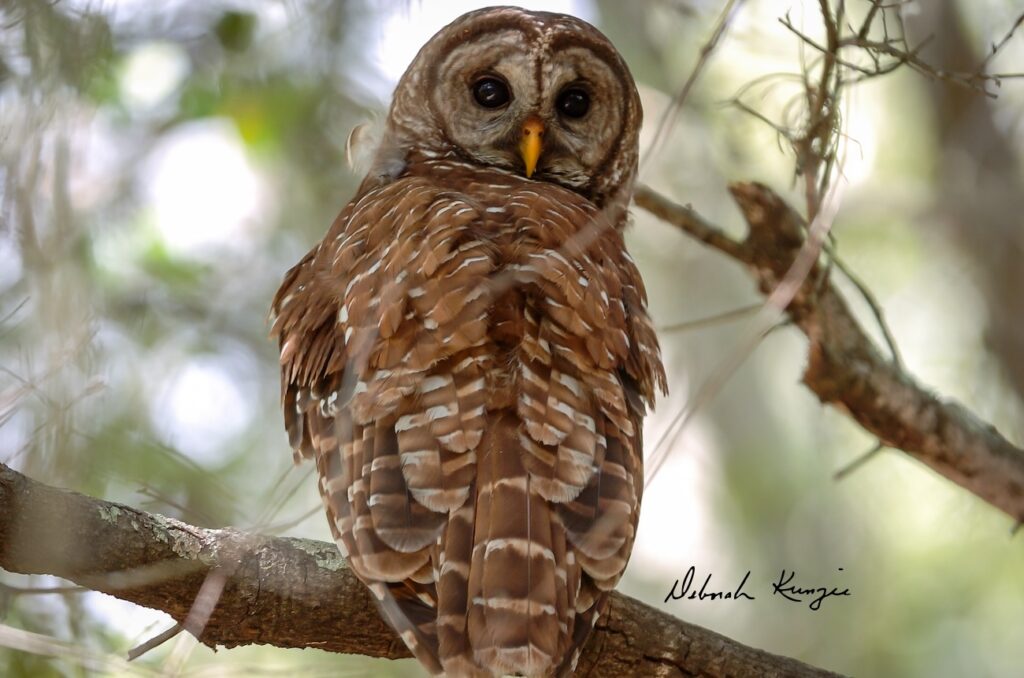Some moments stretch themselves thin across time, becoming something more than just points on a line. Like right now, as I sit on this branch in the Florida woods, turning my head just so to look at that photographer below who thinks she’s being subtle. There’s something almost endearing about the way you humans try to be quiet in our world—as if volume were the only measurement of disturbance.
I’m what your guidebooks call a Barred Owl, Strix varia to the scientifically minded. We’re the ones with the ghostly face—not the heart-shaped mask of the Barn Owl, but more of a circular ring, like ripples spreading from the point where consciousness touches reality. My feathers are a symphony of browns and whites, vertical bars across the chest that give me my name. But what the books don’t tell you is how each marking tells a story about adaptation, about becoming one with the shifting shadows of ancient trees.
The photographer below has been here for hours. I’ve watched her set up her tripod, check camera setting, adjust the lens. She’s captured my image, sure, but there’s a difference between capturing and understanding. William Blake wrote about seeing “a World in a Grain of Sand and a Heaven in a Wild Flower.” But sometimes I wonder if you humans get so caught up in the grain of sand that you miss the entire beach spreading out before you.

My territory encompasses these moss-draped trees, the cypress knees that rise like silent sentinels from dark water, the palmetto undergrowth where cotton rats scurry between roots. I don’t migrate—why would I? These Florida woods hold all the mysteries one bird could ponder in a lifetime. My home range might span 200 to 400 acres, but every acre contains infinities if you know how to look.
When twilight arrives, I begin my rounds. My flight is nearly silent—special feather adaptations comb the air without making a sound. But this isn’t just about physiology. It’s about presence. About moving through the world without disturbing it, becoming part of its natural rhythm rather than imposing your own beat. The Zen masters would understand.
My diet? Small mammals primarily—those cotton rats I mentioned, mice, an occasional young rabbit if fortune favors. But I’m adaptable. In the wet season when water floods these bottom lands, I’ll wade like a heron and snatch crayfish from the shallows. I’ve taken frogs, salamanders, even small fish when they linger too close to the surface. There’s pragmatism in opportunism, a certain wisdom in not holding too tightly to any one way of being.
The photographer thinks he’s documenting me, but I’m observing him too. The way he holds his breath when I turn my head, the slight tremor in his hands when adjusting the focus. He’s seeking something beyond just an image—all artists are. As Diane Arbus said, “A photograph is a secret about a secret. The more it tells you the less you know.” Perhaps that’s what draws him to us night creatures—we embody that paradox.
I chose my mate four breeding seasons ago, and we maintain our bond year-round. We don’t build a new nest each year—we’re not that kind of owl. Instead, we find abandoned hawk nests or natural cavities in these old trees. There’s something satisfying about repurposing what others have left behind, finding value in what’s been overlooked.
In spring, when the swamp fills with frog choruses and the air grows thick with possibility, my mate lays two to three white eggs. She incubates while I patrol our territory, bringing her food, watching for danger. When the owlets hatch—blind, helpless, demanding—we enter an ancient rhythm of care that transcends species. For two months, we hunt ceaselessly to keep those insatiable mouths filled. By midsummer, they fledge, but they’ll stay near us until they master the sacred arts of silent flight and patient waiting.
That’s the true secret, if there is one—patience. Not the passive waiting of indifference, but the active stillness of awareness. I can sit motionless for hours, every sense alert, reading the night’s stories in sounds too subtle for human ears. In this, I suppose I’m more shaman than predator, interpreting the whispers of wind through Spanish moss, the almost-imperceptible rustle of prey through leaf litter.
I’ve weathered hurricanes that turned these woods into chaos, droughts that silenced the frog songs, development that carved our territories into ever-smaller patches. Through it all, we endure. Not through strength or aggression, but through attentiveness to change. As Lao Tzu observed, “Nature does not hurry, yet everything is accomplished.”
As dawn approaches—that liminal time when night creatures yield to day’s chorus—I prepare to roost. Deep in the canopy, where shadows linger longest, I’ll find my place among the branches. Half-awake, half-dreaming, processing the night’s experiences through synapses that remember things older than human language.
The photographer below is packing her gear now, satisfied with his captures. But the real image isn’t in her camera—it’s in the space between us, in the understanding that passes between observer and observed. We owls don’t just watch the night; we are the night’s own eyes, seeing what refuses to be seen, knowing what can’t be told. In the end, maybe that’s what all wisdom comes down to—the ability to sit still long enough for truth to settle on your branch.